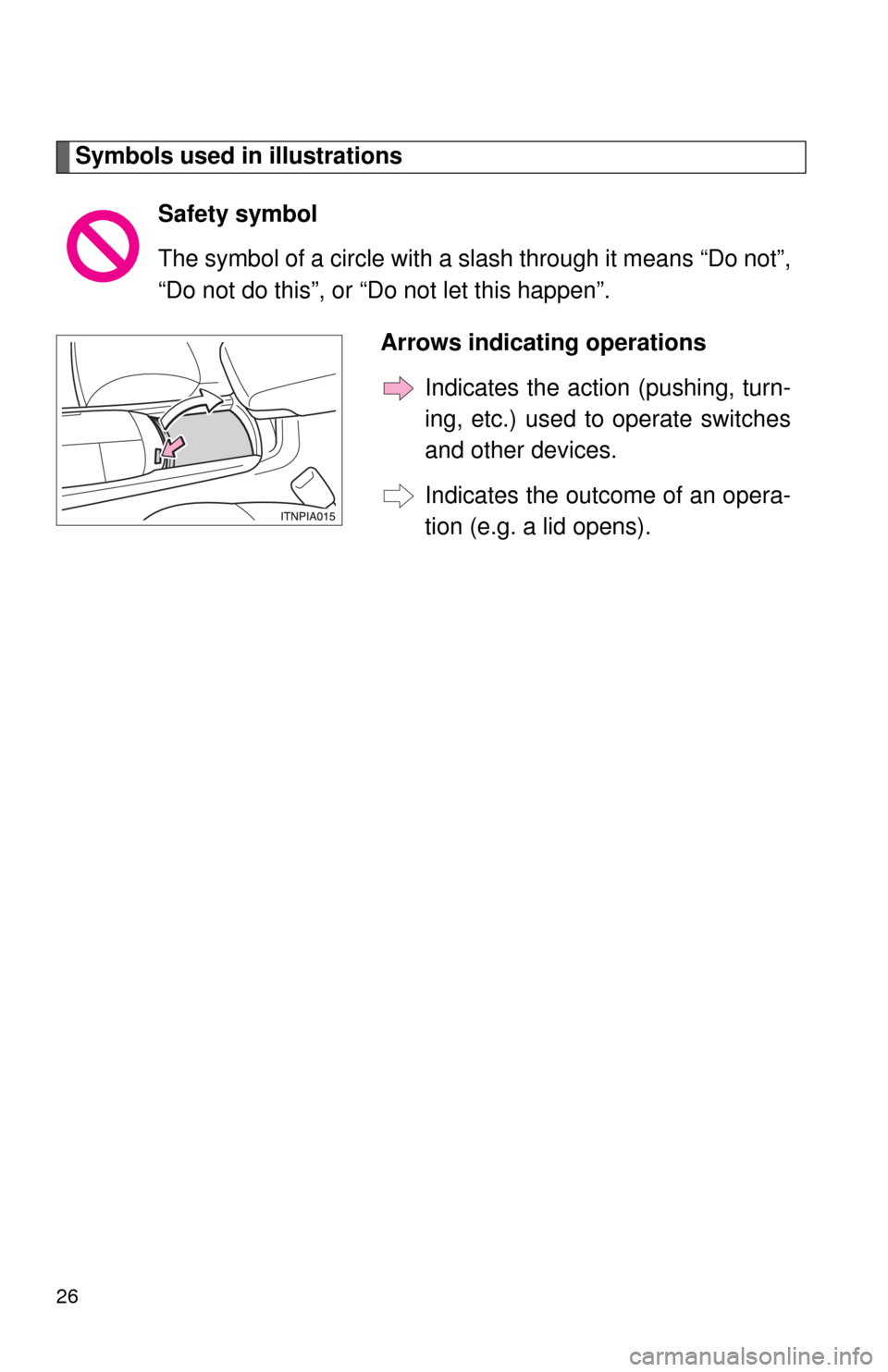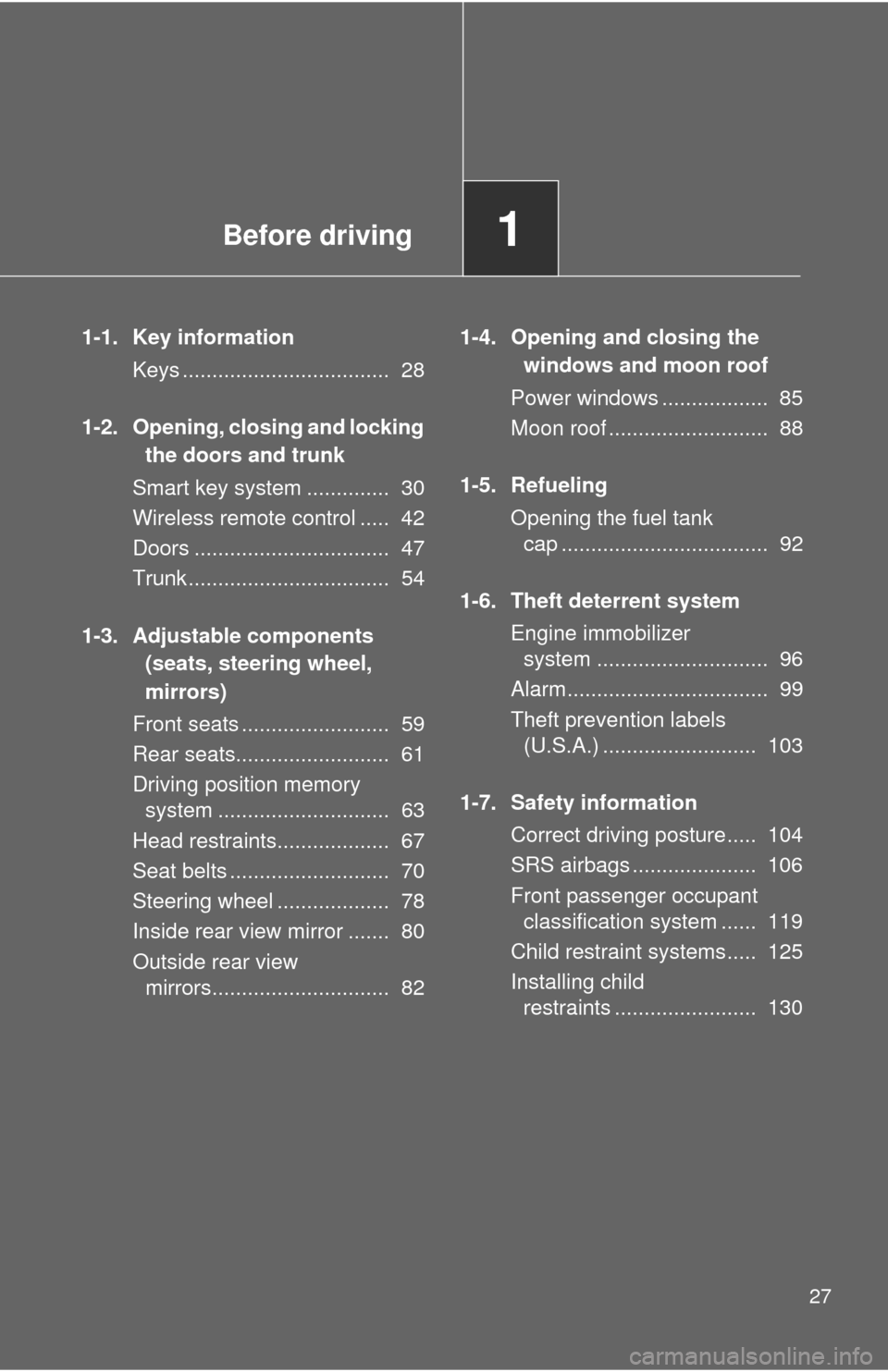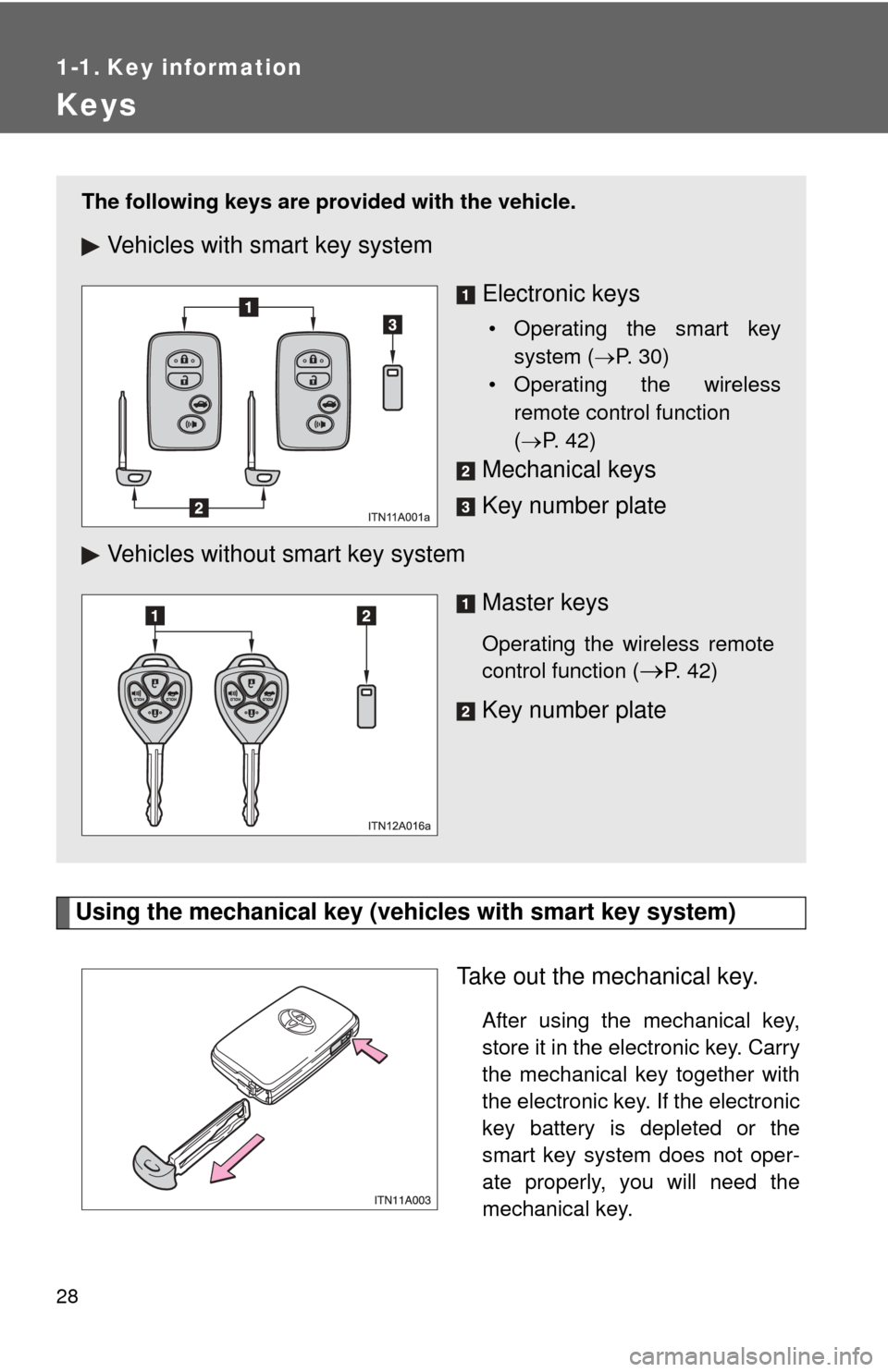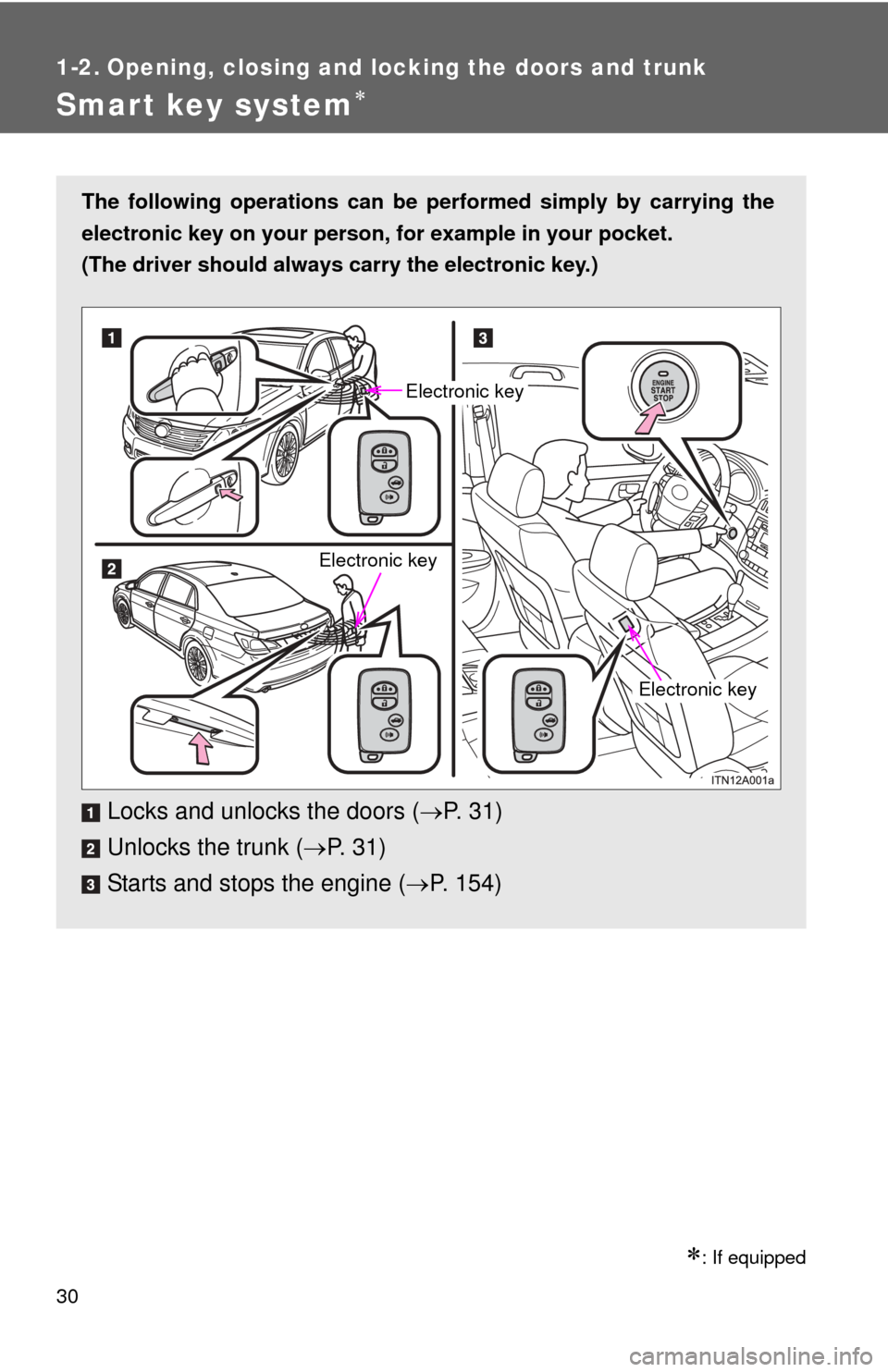TOYOTA AVALON 2012 XX40 / 4.G Owner's Manual
Manufacturer: TOYOTA, Model Year: 2012, Model line: AVALON, Model: TOYOTA AVALON 2012 XX40 / 4.GPages: 580, PDF Size: 9.33 MB
Page 21 of 580

21
Vehicle control and operation data recording
Your Toyota is equipped with sophisticated computers that record certain
information about your vehicle’s operation, such as:
• Engine speed
• Accelerator status
• Brake status
• Vehicle speed
• Shift position
The data recorded varies according to the grade level and options the vehi-
cle is equipped with. The computers do not record conversations, sound or
pictures.
●Data usage
Toyota may use the data recorded in these computers to diagnose malfunc-
tions, conduct research and development, and improve quality.
Toyota will not disclose the recorded data to a third party except:
• With the consent of the vehicle owner or with the consent of the lessee if the vehicle is leased
• In response to an official request by the police, a court of law or a govern- ment agency
• For research purposes where the data is not tied to a specific vehicle or vehicle owner
Page 22 of 580

22
Event data recorder
This vehicle is equipped with an event data recorder (EDR). The main pur-
pose of an EDR is to record, in certain crash or near crash-like situations,
such as an air bag deployment or hitting a road obstacle, data that will assist
in understanding how a vehicle’s systems performed. The EDR is designed
to record data related to vehicle dynamics and safety systems for a short
period of time, typically 30 seconds or less.
The EDR in this vehicle is designed to record such data as:
• How various systems in your vehicle were operating;
• Whether or not the driver and passenger safety belts were buckled/fas-tened;
• How far (if at all) the driver was depressing the accelerator and/or brake pedal; and,
• How fast the vehicle was traveling.
These data can help provide a better understanding of the circumstances in
which crashes and injuries occur.
NOTE: EDR data are recorded by your vehicle only if a non-trivial crash situ-
ation occurs; no data are recorded by the EDR under normal driving condi-
tions and no personal data (e.g., name, gender, age, and crash location) are
recorded. However, other parties, such as law enforcement, could combine
the EDR data with the type of personally identifying data routinely acquired
during a crash investigation.
To read data recorded by an EDR, special equipment is required, and access
to the vehicle or the EDR is needed. In addition to the vehicle manufacturer,
other parties, such as law enforcement, that have the special equipment, can
read the information if they have access to the vehicle or the EDR.
Page 23 of 580

23
●Disclosure of the EDR data
Toyota will not disclose the data recorded in an EDR to a third party except
when:
• An agreement from the vehicle’s owner (or the lessee for a leased vehicle) is obtained
• Officially requested by the police or other authorities
• For use by Toyota in a lawsuit
• Ordered by a court of law
However, if necessary, Toyota will:
• Use the data for research on vehicle safety performance
• Disclose the data to a third party for research purposes without disclosing information about the specific vehicle or vehicle owner
Page 24 of 580

24
CAUTION
■General precautions while driving
Driving under the influence: Never drive your vehicle when under the influ-
ence of alcohol or drugs that have impaired your ability to operate your vehi-
cle. Alcohol and certain drugs delay reaction time, impair judgment and
reduce coordination, which could lead to an accident that will hurt or kill you,
your occupants or others.
Defensive driving: Always drive defensively. Anticipate mistakes that other
drivers or pedestrians might make and be ready to avoid accidents.
Driver distraction: Always give your full attention to driving. Anything that dis-
tracts the driver, such as adjusting controls, talking on a cellular phone or
reading can result in a collision with resulting death or serious injury to you,
your occupants or others.
■ General precautions regarding children’s safety
Never leave children unattended in the vehicle, and never allow children to
have or use the key.
Children may be able to start the vehicle or shift the vehicle into neutral.
There is also a danger that children may injure themselves by playing with
the cigarette lighter, the windows, the moon roof, or other features of the
vehicle. In addition, heat build-up or extremely cold temperatures inside the
vehicle can be fatal to children.
Page 25 of 580

25
Symbols used throughout this manual
Cautions & Notices
CAUTION
This is a warning against anything which may cause injury to people if the
warning is ignored. You are informed about what you must or must not do in
order to reduce the risk of injury to yourself and others.
NOTICE
This is a warning against anything which may cause damage to the vehicle or
its equipment if the warning is ignored. You are informed about what you must
or must not do in order to avoid or reduce the risk of damage to your Toyota
and its equipment.
Page 26 of 580

26
Symbols used in illustrationsSafety symbol
The symbol of a circle with a slash through it means “Do not”,
“Do not do this”, or “Do not let this happen”.
Arrows indicating operationsIndicates the action (pushing, turn-
ing, etc.) used to operate switches
and other devices.
Indicates the outcome of an opera-
tion (e.g. a lid opens).
Page 27 of 580

Before driving1
27
1-1. Key informationKeys ................................... 28
1-2. Opening, closing and locking the doors and trunk
Smart key system .............. 30
Wireless remote control ..... 42
Doors ................................. 47
Trunk .................................. 54
1-3. Adjustable components (seats, steering wheel,
mirrors)
Front seats ......................... 59
Rear seats.......................... 61
Driving position memory system ............................. 63
Head restraints................... 67
Seat belts ........................... 70
Steering wheel ................... 78
Inside rear view mirror ....... 80
Outside rear view mirrors.............................. 82 1-4. Opening and closing the
windows and moon roof
Power windows .................. 85
Moon roof ........................... 88
1-5. Refueling Opening the fuel tank cap ................................... 92
1-6. Theft deterrent system Engine immobilizer system ............................. 96
Alarm.................................. 99
Theft prevention labels (U.S.A.) .......................... 103
1-7. Safety information Correct driving posture..... 104
SRS airbags ..................... 106
Front passenger occupant classification system ...... 119
Child restraint systems..... 125
Installing child restraints ........................ 130
Page 28 of 580

28
1-1. Key information
Keys
Using the mechanical key (vehicles with smart key system)Take out the mechanical key.
After using the mechanical key,
store it in the electronic key. Carry
the mechanical key together with
the electronic key. If the electronic
key battery is depleted or the
smart key system does not oper-
ate properly, you will need the
mechanical key.
The following keys are provided with the vehicle.
Vehicles with smart key system
Electronic keys
• Operating the smart keysystem ( P. 30)
• Operating the wireless remote control function
( P. 42)
Mechanical keys
Key number plate
Vehicles without smart key system Master keys
Operating the wireless remote
control function (
P. 42)
Key number plate
Page 29 of 580

29
1-1. Key information
1
Before driving
■
When required to leave a key to th e vehicle with a parking attendant
(Vehicles with smart key system)
Lock the glove box as circumstances demand. (P. 350)
Remove the mechanical key for your own use and provide the attendant with
the electronic key only.
■ Key number plate
Keep the plate in a safe place such as your wallet, not in the vehicle. In the
event that a key is lost, a new key can be made at your Toyota dealer using
the key number plate. ( P. 504)
■ When riding in an aircraft
When bringing a key onto an aircraft, make sure you do not press any but-
tons on the key while inside the aircraft cabin. If you are carrying a key in
your bag etc., ensure that the buttons are not likely to be pressed acciden-
tally. Pressing a button may cause the key to emit radio waves that could
interfere with the operation of the aircraft.
NOTICE
■To prevent key damage
●Do not disassemble the key.
● Do not subject the keys to strong shocks, expose them to high tempera-
tures by placing them in direct sunlight, or get them wet.
● Do not expose the keys to electromagnetic materials or attach any mate-
rial that blocks electromagnetic waves to the key surface.
Page 30 of 580

30
1-2. Opening, closing and locking the doors and trunk
Smart key system
: If equipped
The following operations can be performed simply by carrying the
electronic key on your person, for example in your pocket.
(The driver should always carry the electronic key.)
Locks and unlocks the doors ( P. 3 1 )
Unlocks the trunk ( P. 3 1 )
Starts and stops the engine ( P. 154)
Electronic key
Electronic key
Electronic key